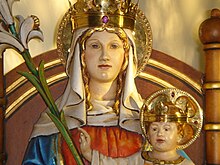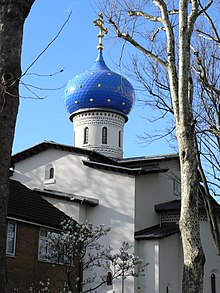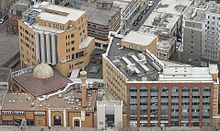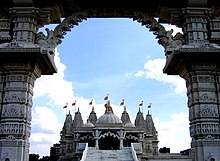Religion in England
| Culture of England |
|---|
 |
| History |
| People |
| Languages |
|
Folklore |
| Cuisine |
| Religion |
|
Art |
| Literature |
Religion in England (2021 census)

Many of England's most notable buildings and monuments are religious in nature: Westminster Abbey, Canterbury Cathedral and St Paul's Cathedral. The festivals of Christmas and Easter are widely celebrated in the country.
Statistics
The 2001 and 2011 censuses did not include on adherence to individual Christian denominations, since they were asked only in the Scottish and Northern Ireland censuses and not in England and Wales.
| Religion | 2001[6] | 2011[7] | 2021[8] | |||
|---|---|---|---|---|---|---|
| Number | % | Number | % | Number | % | |
Christianity |
35,251,244 | 71.7 | 31,479,876 | 59.4 | 26,167,899 | 46.3 |
| No religion | 7,171,332 | 14.6 | 13,114,232 | 24.7 | 20,715,664 | 36.7 |
| Islam | 1,524,887 | 3.1 | 2,660,116 | 5.0 | 3,801,186 | 6.7 |
| Hinduism | 546,982 | 1.1 | 806,199 | 1.5 | 1,020,533 | 1.8 |
| Sikhism | 327,343 | 0.7 | 420,196 | 0.8 | 520,092 | 0.9 |
| Judaism | 257,671 | 0.5 | 261,282 | 0.5 | 269,283 | 0.5 |
| Buddhism | 139,046 | 0.3 | 238,626 | 0.5 | 262,433 | 0.5 |
| Other religion | 143,811 | 0.3 | 227,825 | 0.4 | 332,410 | 0.6 |
| Religion not stated | 3,776,515 | 7.7 | 3,804,104 | 7.2 | 3,400,548 | 6.0 |
| Total population | 49,138,831 | 100.0 | 53,012,456 | 100.0 | 56,490,048 | 100.0 |
Abrahamic religions
Christianity
Demographics
| Year | Pop. | ±% |
|---|---|---|
| 2001 | 35,251,244 | — |
| 2011 | 31,479,876 | −10.7% |
| 2021 | 26,167,899 | −16.9% |
| Religious Affiliation was not recorded prior to 2001. | ||
| Ethnic group | 2021[9] | ||
|---|---|---|---|
| Number | Christians as % of ethnic group | Ethnic group as % of Christian | |
| White | 23,402,349 | 51.12% | 89.43% |
| – British | 20,506,667 | 49.36% | 78.37% |
| – Irish | 354,595 | 71.74% | 1.36% |
| – Roma | 71,268 | 71.89% | 0.27% |
| – Irish Traveller | 40,352 | 62.84% | 0.15% |
| – Other White | 2,152,950 | 60.05% | 8.25% |
| Mixed | 611,454 | 36.63% | 2.34% |
| – White and Black Caribbean | 191,402 | 38.33% | 0.73% |
| – White and Asian | 130,061 | 27.43% | 0.50% |
| – White and Black African | 119,377 | 49.43% | 0.46% |
| – Other Mixed | 170,614 | 37.55% | 0.65% |
| Asian | 555,733 | 10.24% | 2.34% |
| – Indian |
220,688 | 11.97% | 0.84% |
| – Pakistani |
11,953 | 0.76% | 0.05% |
| – Bangladeshi |
2,119 | 0.34% | 0.01% |
| – Chinese | 74,637 | 17.31% | 0.29% |
| – Other Asian | 246,336 | 25.87% | 0.94% |
| Black | 1,598,363 | 67.11% | 6.11% |
| – African | 967,405 | 65.88% | 3.69% |
| – Caribbean | 428,150 | 69.12% | 1.64% |
| – Other Black | 202,448 | 68.90% | 0.77% |
| Other | 276,517 | 22.49% | 1.06% |
| – Arab |
13,278 | 4.15% | 0.05% |
| – Other Ethnic group | 263,239 | 28.96% | 1.01% |
History of Christianity
Protestantism
Church of England (Anglicanism)
The
The Free Church of England is another Anglican denomination which separated from the Church of England in the 19th century in opposition to shifts in doctrine and ceremony which brought the established church closer to Roman Catholicism. The Free Church of England is in communion with the Reformed Episcopal Church in the United States and Canada.
Catholicism

The
Other
No other church in England has more than a million members, with most quite small.

Various forms of Protestantism developed from the ferment of the

Most
There are various
As well as the Russian and Greek Orthodox churches, there are also the
All
Islam


According to the 2021 United Kingdom census, 3,801,186 Muslims live in England, or 6.7% of the population. The Muslim population had grown by over a million compared to the 2011 census.[32]
According to the 2011 Census, 2.7 million Muslims live in England where they form 5.0% of the population.[7]
Although
Muslim scholarship was well known among the learned in England by 1386, when
(Ibn Rushd, Arabic ابن رشد). Ibn Sina's canon of medicine was a standard text for medical students well into the 17th century.Today Islam is the second largest religion in England. About 38% of English Muslims live in London, where they make up 12.4% of the population. There are also large numbers of Muslims in Birmingham, Manchester, Bradford, Luton, Slough, Leicester and the mill towns of Northern England such as Huddersfield, Dewsbury, Oldham.[7]
Notable mosques include the
Judaism

Until the 20th century, Judaism was the only noticeable non-Christian religion having first appeared in historical records during the Norman Conquest of 1066. In fact, from 1290 to 1656, Judaism did not officially exist in England due to an outright expulsion in 1290 and official restrictions that were not lifted until 1656 (though historical records show that some Jews did come back to England during the early part of the 17th century prior to the lifting of the restriction). Now, the presence of the Jewish culture and Jews in England today is one of the largest in the world.
Baháʼí Faith
The
Indian religions
Hinduism

Early Hindus in England were mostly students during the 19th century. There have been three waves of migration of Hindus to England since then.
Before
Sikhism
The first Sikh Gurdwara (temple) was established in 1911, at Putney in London.
The first Sikh migration came in the 1950s. It was mostly of men from the Punjab seeking work in industries like foundries and textiles. These new arrivals mostly settled in London, Birmingham and West Yorkshire. Thousands of Sikhs from East Africa soon followed. This mass immigration was caused by Idi Amin's persecution of ethnic groups in Uganda, with thousands forced to flee the region in fear of losing their lives.[citation needed]
Buddhism

The earliest Buddhist influence on England came through the UK's imperial connections with
In 1924 London's
In the 1970s, a Theravāda monastic order consists mainly of Westerners following the Thai Forest Tradition of Ajahn Chah was established at Chithurst Buddhist Monastery in West Sussex, and also established branches monasteries elsewhere in the country.
Modern paganism
At the 2011 census 75,281
| Pagan Religions | 2011[9] | 2021[38] |
|---|---|---|
| Paganism/Modern pagan religions | 83,762 | 95,931 |
| – Pagan | 53,172 | 68,629 |
| – Wicca | 11,026 | 11,952 |
| – Heathen | 1,867 | 4,479 |
| – Druid | 3,946 | 2,269 |
| – Witchcraft | 1,193 | 975 |
| – Shamanism | 612 | 7,623 |
Wicca
Wicca was developed in England in the first half of the 20th century.[39] Although it had various terms in the past, from the 1960s onward the name of the religion was normalised to Wicca.[40]
Heathenry
Druidism
During the
Other religions
Other religions include:[44]
- Spiritualism
- Ravidassia religion
- Rastafari
- Taoism
- Zoroastrianism
- Satanism
- Shinto
- New Age
- Scientology
- Traditional African religion
- Animism
- Druze
- Confucianism
- Thelema
- Vodun
- Eckankar
- Brahma Kumari
- Occult
- Reconstructionism
| Other religion | 2011[45] | 2021[46] | ||||
|---|---|---|---|---|---|---|
| Spiritualism and new religious movements | 67,666 | 78,851 | ||||
| – Spiritualism1 | 49,361 | 60,912 | ||||
| – Rastafari | 7,657 | 5,802 | ||||
| – Satanism | 1,800 | 4,751 | ||||
| – Pantheism | 2,105 | 2,158 | ||||
| – Scientology | 2,361 | 1,833 | ||||
| – Animism | 487 | 733 | ||||
| – Universalism | 862 | 721 | ||||
| – Occult | 474 | 457 | ||||
| – New Age | 665 | 373 | ||||
| – Eckankar | 367 | 319 | ||||
| – Brahma Kumaris | 434 | 229 | ||||
| – Thelemite |
176 | 209 | ||||
| – Unification Church | 435 | 195 | ||||
| – Mysticism | 192 | 137 | ||||
| – Church of all Religions | 380 | 22 | ||||
| Indian Religions | 31,238 | 35,485 | ||||
| – Jainism | 20,193 | 24,887 | ||||
| – Ravidassia | 11,045 | 9,564 | ||||
| – Valmiki | 1,034 | |||||
| Alevism | 25,460 | |||||
| Mixed Religion(s) | 21,907 | 10,981 | ||||
| Iranian Religions | 8,801 | 8,910 | ||||
| – Bahá'í Faith |
4,746 | 4,489 | ||||
| – Zoroastrianism | 4,055 | 4,029 | ||||
| – Yazidism | 392 | |||||
| East Asian Religions | 5,247 | 5,287 | ||||
| – Taoism | 3,916 | 3,525 | ||||
| – Shinto | 1,041 | 1,337 | ||||
| – Chinese Religions | 174 | 109 | ||||
| – Confucianism | 116 | 76 | ||||
| Other religions | 21,060 | 71,760 | ||||
| – Theism2 | 3,618 | 3,143 | ||||
| – Own Belief System | 1,842 | 2,067 | ||||
| – Deism | 1,142 | 1,036 | ||||
| – Reconstructionism | 223 | 697 | ||||
| – Traditional African religion |
584 | 651 | ||||
| – Druze | 504 | 619 | ||||
| – Vodon |
198 | 246 | ||||
| – Native American Church | 119 | 74 | ||||
| – Other religions | 12,830 | 63,227 | ||||
| Total population | 155,919 | 217,804 | ||||
| 1 includes people who reported "spiritual" | ||||||
| 2 includes people who reported "Believe in God" | ||||||
Historical religions

These faiths, all of which are considered to be
Gallo-Roman religion
Eastern cults such as
Germanic paganism
In the
Notable places of worship
The varied religious, denominational, racial, and ethnic history of England has left a wide range of religious buildings—
- Amaravati Buddhist Monastery – Buddhist
- Bevis Marks Synagogue – Jewish
- Birmingham Central Mosque – Islamic
- Brompton Oratory – Roman Catholic
- Canterbury Cathedral – Church of England
- Finsbury Park Mosque – Islamic
- Gurdwara Sri Guru Singh Sabha– Sikh
- Jamea Masjid – Islamic
- London Buddhist Centre – Buddhist
- London England Temple – Church of Jesus Christ of Latter-day Saints
- Metropolitan Tabernacle – Baptist
- Neasden Temple– Hindu
- Preston England Temple – Church of Jesus Christ of Latter-day Saints
- Salisbury Cathedral – Church of England
- Church of St Lazar– Serbian Orthodox
- St Chad's Cathedral– Roman Catholic
- St Paul's Cathedral – Church of England
- Saint Sophia Cathedral– Greek Orthodox
- Stanmore and Canons Park Synagogue – Jewish
- Victoria Park Mosque– Islamic
- Wat Buddhapadipa – Buddhist
- Westminster Abbey – Church of England
- Westminster Cathedral – Roman Catholic
- Westminster Central Hall– Methodist
- York Minster – Church of England
- Saint Hill Manor – Church of Scientology
Irreligion
36.7% of people in England declared no religion in 2021, compared with 24.7% in 2011 and 14.6% in 2001. These figures are slightly lower than the combined figures for England and Wales as Wales has a higher level of irreligion than England.[7] Brighton and Hove had the highest such proportion at 55.2%, followed by Norwich at 53.5%, Bristol and Hastings at 51.4%[50]
| Ethnic group | 2021[9] | |
|---|---|---|
| Number | % of ethnic group reported no religion | |
| White | 19,156,458 | 41.84 |
| – British | 18,104,217 | 43.58 |
| – Irish | 105,736 | 21.39 |
| – Roma | 17,337 | 17.59 |
| – Irish Traveller | 18,120 | 28.22 |
| – Other White | 911,048 | 25.41 |
| Asian | 481,282 | 8.87 |
| – Indian |
83,109 | 4.51 |
| – Pakistani |
18,149 | 1.16 |
| – Bangladeshi |
9,024 | 1.43 |
| – Chinese | 269,092 | 62.41 |
| – Other Asian | 101,908 | 10.70 |
| Black | 202,935 | 8.52 |
| – African | 52,821 | 3.60 |
| – Caribbean | 115,144 | 18.59 |
| – Other Black | 34,970 | 11.90 |
| Mixed | 726,429 | 43.51 |
| – White and Black Caribbean | 256,376 | 51.35 |
| – White and Asian | 221,505 | 46.71 |
| – White and Black African | 79,263 | 32.82 |
| – Other Mixed | 169,285 | 37.26 |
| Other | 148,562 | 12.09 |
| – Arab |
15,405 | 4.81 |
| – Other Ethnic group | 133,157 | 14.65 |
| TOTAL | 20,715,664 | 36.7 |
See also
- Acts of Supremacy
- Dissolution of the Monasteries
- Gunpowder Plot
- History of the Church of England
- Putting away of Books and Images Act 1549
- Wembley’s Conference of Living Religions 1924
- Religion in the United Kingdom
- Religion in Birmingham
- Religion in London
References
- ^ "Home". Canterbury Cathedral. Retrieved 10 March 2023.
- ^ "Religion (2019)". ons.gov.uk. Retrieved 7 October 2022.
- ^ "Shamanism: What you need to know about the fastest-growing 'religion' in England and Wales". 5 January 2023.
- ^ Guidance and Methodology, Religion, retrieved 31 January 2014.
- ^ "Understanding the 21st Century Catholic Community" (PDF). CAFOD, Ipsos MORI. November 2009. Archived from the original (PDF) on 15 September 2016. Retrieved 6 May 2018.
- ^ "Religion (2001 Census)". data.gov.uk. 9 February 2010. Retrieved 17 December 2012.
- ^ a b c d "2011 Census: KS209EW Religion, local authorities in England and Wales". ons.gov.uk. Retrieved 15 December 2012.
- ^ "Religion, England and Wales - Office for National Statistics". www.ons.gov.uk. Retrieved 29 November 2022.
- ^ a b c "UK Government Web Archive".
- ^ Gledhill, Ruth (15 February 2007). "Catholics set to pass Anglicans as leading UK church". The Times. London. Archived from the original on 18 September 2011. Retrieved 18 February 2015.
- ^ "How many Catholics are there in Britain?". BBC. London. 15 September 2010. Retrieved 18 February 2015.
- ^ "2009 Church Statistics" (PDF). Church of England. 2009. Archived from the original (PDF) on 8 April 2016. Retrieved 13 February 2015.
- ^ See the pages linked from "Life Events". Church of England. Archived from the original on 22 November 2010. Retrieved 13 February 2015..
- ^ Bowler, Peter J. (2001). Reconciling science and religion: the debate in early-twentieth-century Britain. Chicago: University of Chicago Press. p. 194..
- ^ "Facts and Stats". Church of England.
- ^ "Research and Statistics". Church of England. Retrieved 9 May 2012..
- ^ Elenna Curti and Christopher Lamb, "Cathedral countdown to installation," The Tablet, 16 May 2009, 39.
- ^ Lucy Wooding, "Binding Identities," The Tablet, 26 June 2011, 26.
- ^ "Archbishop of Westminster Vincent Nichols is made cardinal," The Telegraph, 22 February 2014.
- ^ Bishop, Erin I. 'My Darling Danny': Letters from Mary O'Connell to Her Son Daniel, 1830–1832. Cork: Cork University Press, 1998
- ^ William Maziere Brady, Annals of the Catholic Hierarchy in England and Scotland A.D. 1585-1876 (London: J.M. Stark, 1883).
- ^ "Royal nod for daughters, Catholics". The Age. Melbourne. 29 October 2011.
- ^ a b Wynne-Jones, Jonathan (23 December 2007). "Britain has become a 'Catholic country'". The Telegraph. Retrieved 18 February 2015.
- ^ "Numbers Game," The Tablet, 31 October 2009, 16.
- ^ 'Fringe' Church winning the believers The Times, 19 December 2006(subscription required)
- ^ "Who are the Mennonites?". London Mennonite Centre. Retrieved 5 September 2008. [dead link]
- ^ "Current Hierarchs of the Archdiocese of Great Britain". Orthodox Research Institute. 2008. Archived from the original on 16 March 2002. Retrieved 5 September 2008.
- ^ Archbishop Gregorios of Thyateira & Great Britain (21 April 2000). "The Archdiocese of Thyateira and Great Britain and Orthodoxy in the British Isles". Archdiocese of Thyateira and Great Britain. Retrieved 5 September 2008.
- ^ "Welcome". Russian Orthodox Diocese of Sourozh. Archived from the original on 23 June 2008. Retrieved 5 September 2008.
- Greek Orthodox Church of Antioch Deanery of the United Kingdom and Ireland. 2008. Retrieved 5 September 2008.[permanent dead link]
- ISBN 0520204042. Retrieved 24 April 2015.
The mosque committee was determined from the outset, moreover, to remind local people of the building's religious function as loudly as possible. As one of the few mosques in Britain permitted to broadcast calls to prayer (azan), the mosque soon found itself at the center of a public debate about "noise pollution" when local non-Muslim residents began to protest.
- ^ "Religion, England and Wales - Office for National Statistics". www.ons.gov.uk. Retrieved 30 November 2022.
- ^ Gold imitation dinar of Offa Archived 12 September 2012 at archive.today, British Museum
- ^ Baháʼí Information Office (United Kingdom) (1989). "First Public Mentions of the Baháʼí Faith". Archived from the original on 26 February 2008. Retrieved 18 February 2008.
- ^ The Baháʼí Faith in Cumbria Archived 22 February 2010 at the Wayback Machine bci.org accessed 6 January 2009
- ^ Welcome to the Baháʼís of Cornwall website of Cornish Baháʼís, accessed. 6 January 2009
- ^ a b 2011 ONS results
- ^ "Religion, England and Wales - Office for National Statistics".
- ISBN 0-19-820744-1.
- ^ Seims, Melissa (2008). "Wica or Wicca? – Politics and the Power of Words". The Cauldron (129).
- ^ Asatru UK | Facebook Available at: https://www.facebook.com/groups/AsatruUK/members [Accessed February 13, 2022]
- ^ Robert Booth (11 December 2012). "Census 2011 data on religion reveals Jedi Knights are in decline". The Guardian. Retrieved 11 December 2014.
- ^ "UK 2011 Census Publishes Figures for Druids". The Order of Bards Ovates & Druids. Archived from the original on 13 June 2013. Retrieved 12 January 2012.
- ^ Simon Rogers (11 December 2012). "Census 2011: how many Jedi Knights are there in England & Wales?". The Guardian. Retrieved 11 December 2014.
- ^ "Data Viewer - Nomis - Official Census and Labour Market Statistics".
- ^ "Religion (Detailed) - Office for National Statistics".
- ^ Julius Caesar, Commentarii de Bello Gallico 6.13
- ^ Suetonius, Claudius 12.5
- ^ Tacitus, Annals 14.30
- ^ "Religion, England and Wales - Office for National Statistics".
External links
- Reassessing what we collect website History of minority religions in London with objects and images
Further reading
- Bebbington, David W. Evangelicalism in Modern Britain: A History from the 1730s to the 1980s (Routledge, 2003)
- Chadwick, Owen, The Victorian Church: Vol 1 1829–1859 (1966); Victorian Church: Part two 1860–1901 (1979); a major scholarly survey
- Davie, Grace. Religion in Britain since 1945: Believing without belonging (Blackwell, 1994)
- Davies, Rupert E. et al. A History of the Methodist Church in Great Britain (3 vol. Wipf & Stock, 2017). online
- Gilley, Sheridan, and W. J. Sheils. A History of Religion in Britain: Practice and Belief from Pre-Roman Times to the Present (1994) 608pp excerpt and text search
- Hastings, Adrian. A History of English Christianity: 1920–1985 (1986) 720pp a major scholarly survey
- Hylson-Smith, Kenneth. The churches in England from Elizabeth I to Elizabeth II (1996).
- Marienberg, Evyatar. Religion in England from Prehistoric Times to the Early 1980s: With a special emphasis, when relevant, on Catholicism, and the country’s North East (2021) 135pp amazon
- Marshall, Peter. "(Re)defining the English Reformation," Journal of British Studies, July 2009, Vol. 48#3 pp. 564–586
- Thomas, Keith. Religion and the decline of magic: studies in popular beliefs in sixteenth and seventeenth-century England (1991), a study of popular religious behaviour and beliefs
- Voas, David, and Alasdair Crockett. "Religion in Britain: Neither believing nor belonging." Sociology 39.1 (2005): 11–28. online
Primary sources
- Horace Mann (1854). Census of Great Britain, 1851: Religious Worship in England and Wales. Ge. Routledge.
